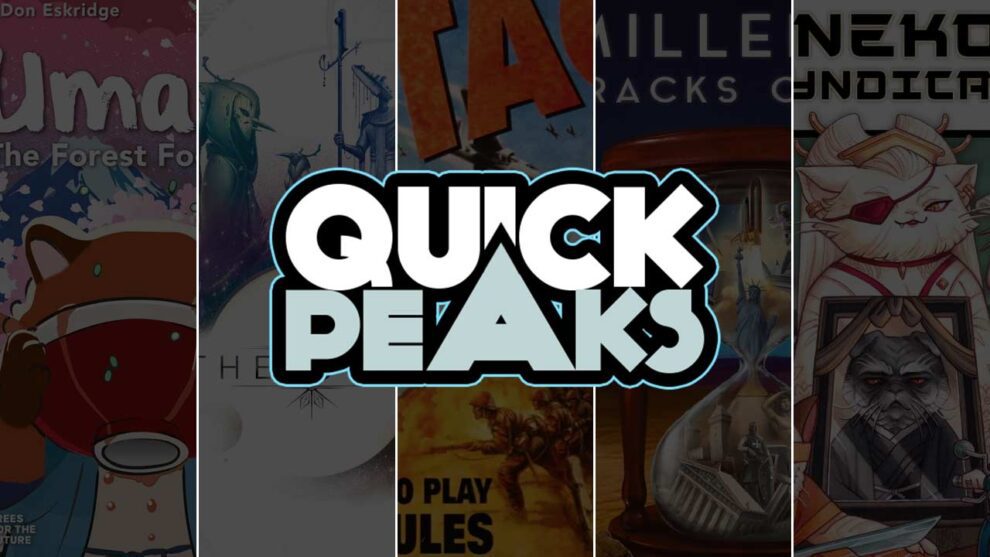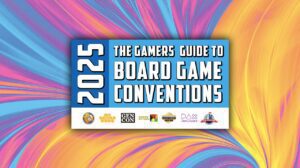Umami – Justin Bell
I keep trying HeidelBÄR games released by Czech Games Edition, and I keep coming up short. Umami, the latest in a line of family-friendly, light “take that” card games featuring cute art, is designed by a person of relative weight in the tabletop space: Don Eskridge, the man behind The Resistance and Quest. That was enough to at least raise my hand to try out Umami…but there’s strangely not much game here.
Players use ingredient cards from their hand and from a four-card market to build dishes that will then be fulfilled by public contracts known here as “Favorites.” Each turn, a player will play one card from hand then add one card from the market to build out as many as five dishes in their tableau. As soon as a Favorite condition is met, the player takes that card and can hold it as long as no one else tries to steal it by making a more favorable version of the Favorite’s fulfillment condition. The game’s ingredient cards have values from 1-9, and this factors into whether a player can steal a Favorite card by outperforming it and stealing it later.
I teed up Umami with my two kids, and we were surprised to find that stealing a neighbor’s ingredients or Favorite cards was usually not necessary…because it was usually easy enough to just fulfill Favorites straight up. Without thievery, Umami really suffers, and the game feels a little too easy to end quickly if no one is interested in playing ball with the game’s intentions. Umami was easy to teach and the art is cute, but unfortunately no one in the tabletop media space is talking about this game for a reason.
Ease of entry?
★★★★★ – No sweat
Would I play it again?
★★☆☆☆ – Would play again but would rather play something else
Read more articles from Justin Bell.
Etherstone – Kevin Brantley
I have a buddy I call a “silent investor” because he backs so many Kickstarters but doesn’t tell anyone until the games show up. Here’s one I had never heard of, but I was surprised when I saw Luciani’s name on the box. “It’s sort of like Res Arcana,” he mentions as he unpacks the deluxified card sleeves.
Now, I have a love/hate relationship with Res Arcana. I used to play it a bunch on BGA, and some games are full of juicy combos and others that just fall flat from bad card distribution.
Etherstone is conceptually similar, as you only have seven cards (plus one leader) for the entire game. Gameplay is simple: your base actions are drafting dice for resources, playing a card by paying its cost, or attacking a monster in the communal pool. Cards come in two types: minions and rituals, and there’s plenty of room for satisfying synergy. Another interesting twist is the dice drafting powers: drafting a specific value can trigger multiple effects, setting up some fun combos.
The game also leans heavily into direct conflict. Many cards deal damage to other players, and while losing all your leader’s health doesn’t eliminate you, it does saddle you with a whopping -7 points at the end of the game. When the average score hovers around 20–30, two deaths will almost certainly land you in last place.
I really enjoyed my first game with the preset decks. The real puzzle is strategically planning when to play each card—some are better early, others shine late, and timing is everything. My second game, though, was absolutely terrible. We did the normal card draft, and while I thought I was being clever, leaning into one trait, it ended up being my downfall. I went too heavy in one direction and found myself resource-poor.
The gameplay loop is easy to learn, but the strategy runs deep. With such a huge stack of cards to draft from, no two games will feel the same, which is great, but also frustrating if you end up with a bad draft. It’s a small-box card game with a big experience.
Ease of entry?:
★★★☆☆ – There were a few questions
Would I play it again?
★★★★★ – Will definitely play it again
Read more articles from Kevin Brantley.
Attack! – K. David Ladage
I was at GenCon around the time the expansion for Attack! was released (Attack!: Expansion). The guys at Eagle games had a room where they had set up a giant board that covered the whole floor and used giant pieces you had to walk out onto the board to move. It was glorious. I watched and decided that the game was a relatively simple game somewhere between Risk and Axis and Allies. In the end, I decided against the purchase.
While attending the latest session of Congress of Gamers, I met up with a wonderful gentleman named Joe who had the game set up and was just waiting to see if someone would join him. I asked my friend Mike and we joined in. Joe had some house rules he used and so the game was, at times, a bit on the confusing side. The pieces were in plastic bags, which made it tough to find the right units sometimes. Despite the hiccups, we all had a good time.
This session of Congress of Gamers was different than most. On Sunday, they usually have a rummage sale where you can buy game bits and pieces on the cheap. This session, however, had a triple-estate sale with some 1,300 games going for rock bottom prices. In that sale, there were three copies of Attack! (two in shrink, the opened one in a larger box with an organizer), two copies of the Expansion, and a copy of the Deluxe version. After a bit of research, I realized that the Deluxe box was an updated expansion box. So, I purchased a copy of the base game and the Deluxe Expansion. Then, I purchased that open one with the organizer and gave it to Joe. He can organize his game better now. We agreed to get together at the next session and play again!
Ease of entry?
★★★☆☆ – There were a few questions
Would I play it again?
★★★★★ – Will definitely play it again
Read more articles from K. David Ladage.
Millennia: Tracks of Time – David McMillan
During a recent vacation, I was fortunate enough to get one of my newest acquisitions, Millennia: Tracks of Time, to the table. This is a card-drafting game that takes the players on a voyage through the various eras of human evolution—from the stone age to the space age—using a ‘tag’ system similar to other games such as 7 Wonders or Terraforming Mars.
The game takes place over 8 eras, which are subdivided into several turns. During a turn, players take turns drafting cards from several lineups of cards, earning income based on which rows the drafted cards came from, and then using their drafted cards (along with cards drafted in previous rounds) to move up the titular tracks. Each track has a specific combination of tags (provided by the drafted cards) that need to be expended to move along them. In general, the higher a player is able to climb along the various tracks, the better the immediate bonuses they’ll earn, and the higher the points they’ll score at the end of the game. But, climbing up the tracks isn’t the only way to score points. Players are also able to spend their money to construct buildings which provide various ongoing benefits or end game scoring conditions.
What really sets Millennia apart is the “of Time” portion of its moniker. Nothing in Millennia lasts forever. Old technologies fall to the wayside and become obsolete as new discoveries are made. Each card has a timer on it that indicates how long you can expect it to stick around in your collection. So, you’re not just drafting for the tags the cards produce, but you’re also drafting for longevity.
I really enjoyed this game. My wife enjoyed it, too. The decision space is entrancing, and we both found ourselves standing up out of our chairs at various points, poring over the game state, strategizing and plotting our next moves. I look forward to playing it again.
Ease of entry?
★★★☆☆ – There were a few questions
Would I play it again?
★★★★★ – Will definitely play it again
Read more articles from David McMillan.
Neko Syndicate – Andy Matthews
We reviewed Neko Syndicate near the end of last year, giving it a very favorable 4.5 star rating. So when I had the chance to play it earlier this week I was very interested. As I read through our review my smile grew bigger and bigger: sushi-producing mafia cats, network optimization puzzle, spatial placement? Check, check, and check! The added bonus was that since my youngest son loves cats, I got him to play with me.
Setup was easy, and after a few minutes explaining the rules, we were off to the races. The game suggests that players could make simultaneous moves, but since we’re both first-timers we opted to take turns so that we could help each other. Neko Syndicate is one of those games that starts off lightning fast, but whose turns take gradually more time. Choosing where to place cats in your network, and whether to send your mafia boss left or right, when to deliver sushi vs when to make rice…it’s a challenging puzzle.
Because of our choice to take turns instead of play at the same time, our game took about an hour. And by the end, the game ended up being a bit more of a brain burner than my son could tolerate. But we finished strong and had a fun time. If you get the chance to try this one out, give it a shot!
Ease of entry?
★★★★☆ – The odd bump or two
Would I play it again?
★★★★☆ – Would like to play it again












